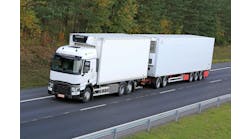If you're a jalapeÒo pepper, it's a long way from the growing fields in Honduras, onto a ship, through the ports of Houston or Miami and into someone's salsa in Cleveland. The 2,500-mile journey can be tough on vegetables, and even tougher on transport packaging. Opting to use the IPL SmartCrate (IPL, Worcester, Mass.), a collapsible and reusable crate designed to replace single-use containers, has paid off for Mount Dora Farms (Houston) in one year.
"Cost was definitely our main driver," says Chris Corette, general manager. "And the ideal solution was a bag-in-a-box."
He says the search for the right transport packaging combination—in this case the collapsible crate and polyurethane bag—lasted about a year, but it was worth the effort because of the cost savings over one-time use containers.
A long and winding road
For Mount Dora Farms, the supply chain route begins in the Honduras. Farmers there grow the hot peppers— processing more than 12 million pounds of jalapeÒos annually—and then ship them to Mount Dora facilities in Miami and Houston. Next, the peppers are transported to major food processors in the Midwest. Previously, the peppers made the entire trip in five-gallon buckets.
The route from Honduras to Florida and Texas worked well enough, but as soon as the pails arrived in the States, the costs began to heat up. Empty pails were loaded in four layers on a pallet. This did not make the best use of expensive refrigerated warehouse space. Transporting the pails by truck from Mount Dora's warehouses to customers in the Midwest was expensive.
A better way
Now, Mount Dora Farms packs its jalapeÒos and liquid in a specially designed polyurethane bag, then vacuum seals the contents. Each bag is nestled within the 11-inch-high IPL Smart-Crate. The bags carry the same weight and volume as did the pails previously.
The crates have a unique design that enables static load weights to be distributed through the corners directly to the pallet surface. This results in a much higher stack-load capacity than some other collapsible containers. As a result, Mount Dora can double stack the loaded pallets, which weigh almost 2,200 pounds each, to maximize its cold storage space utilization.
"With these containers, we can store pallets full of product indefinitely," says Corette, "if we had to, and they would not collapse."
At the receiving end, plant workers move pallets directly to the processing line. There, employees cut the bags and empty the contents. The crates are collapsed and stacked 145 units to a pallet. The food processor stores the collapsed crates until Mount Dora Farms picks them up and returns them to its own facilities. Because the crates collapse, they can be stored in less space than nestable containers.
"It's much easier for the customer to warehouse the collapsed crates than the empty pails or nestable containers" says Corette. "And they no longer have to dispose of empty pails."
The container evaluation program Mount Dora used field tested the viability of various shipping units along with effectiveness of managing the pool of containers internally, versus having a national container pooling service manage the fleet.
"We found that owning and managing our own fleet of containers is the most effective way," says Corette. "We just load up the empties from the customer site whenever we send up a truck. The system runs very smoothly."
Even though its previous experience with rail transport was less than satisfactory, Mount Dora recently started to ship the jalapeÒo peppers to its Midwest customers by rail. "We've tested the containers and know we can [ship by rail] without any damage to the peppers or the crates," says Corette.


